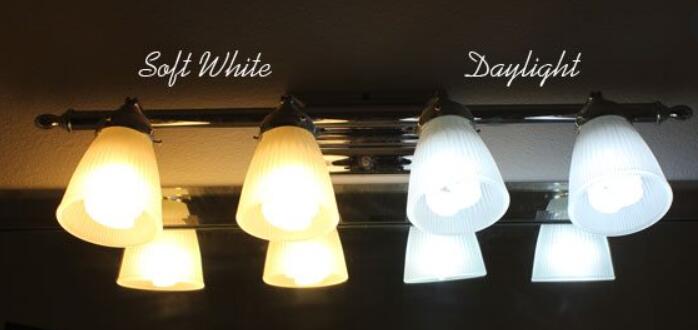Lighting and color temperature hold a great significance in setting the mood of an area and making the objects look more gleaming.
Too bright and your place starts to look like a freaking science lab. Too low and now you have a dark and dull space with a dead mood.
Thus, to set the right mood and enhance the interiors of your house or office, you need to select the right kinds of bulbs for different rooms.
When it comes to setting the tone, color temperatures play a major role in lighting. When used in the correct manner, color temperature can completely alter how an area or object is perceived when illuminated.
Mainly, there are 2 color temperatures that are widely used to set and alter the tone: Soft White vs Daylight Light.
So before you go shopping for bulbs, let’s learn the difference between these two types and see which one would be the best for you.

Soft White
Soft white lighting lies primarily in the orange and yellow color range of the Kelvin scale. A typical soft white bulb has a temperature of around 2700 to 3000 K on the Kelvin scale.
These types of bulbs produce a warmer tone and interact with other warm colors of the room such as reds, oranges, and browns.
Soft light is best suitable for areas where you want to have ambient lighting. It helps in creating warm and cozy spaces and encourages a comfortable and relaxing environment.
Another great thing about the soft white light is that it is soothing for the eyes, the warm yellow tone can easily help in relaxing your mind, body, and eyes, resulting in better sleep.
Usage:
Due to their low-temperature range, it’s best to use soft white lighting for the overall illumination of big areas such as living rooms, kitchens, bedrooms, etc.
Its uniform and warmer tone will create a cozy space where you can relax, read a book, cook, or sleep.
Daylight
Daylight lighting lies higher on the kelvin scale with color temperatures ranging between 4600 to 6500K. This type of lighting gives brighter and whiter light and has blue color tones.
Daylight bulbs mimic natural sunlight (which lies between 5600K to 6500K), provide better contrast, and are a great choice for places where you want to see intricate details.
These lights provide a clearer hue and better contrast and let your eyes see intricate details and colors more distinctively.
They radiate a more bright and energetic light and are a great option for task lighting.
By mimicking true sunlight, these lights create a more jazzy mood and improve the productivity and mental awareness of a person.
Usage:
With their high-temperature range, daylight bulbs are best for task lighting.
They create a productive and energetic mood and help you provide a focused bright illumination to a particular space.
Daylight bulbs will work great for any area of your bathroom and the cooking area of your kitchen.
If you have a desk lamp or do long hours of detailed work in your living room, going for daylight bulbs will be better for your eyes.
How to Choose Between Soft White and Daylight Lamps and Bulbs?
Setting the perfect mood doesn’t mean you only have to go with one type of bulb and lamp for your whole house.
Depending on various factors, the area can have soft white light, daylight, or even a combination of both to get that aesthetic-looking space.
Let’s check some of the factors that can help you decide.
1. Function of the room
First and foremost, you have to get clear on the activities or tasks that you perform in the particular area.
Even though you might feel like choosing one color temperature, it’s possible that a mix of both lamps will give you the desired illuminance.
For example, soft white lights are great to create a relaxing environment in your kitchen and eating area while a daylight bulb nearby your cooking area will be a better choice.
2. Mood you want: Task light or Ambiance light?
How do you want to feel in space?
Do you want a relaxing and comfy space that is pleasing to the eyes or do you need to create an energetic mood where you can focus and work for long hours?
Soft white can give you that warm and cozy feeling, while daylight lamps can help in increasing productivity and focus.
3. Room size
Different room sizes have different lighting requirements. You can easily determine how much light you need by measuring and calculating your room’s square footage and foot-candle measurements.
For example, a bedroom requires around 10-20 lumens per square foot while a kitchen requires strong lighting of around 70-80 lumens per square foot.
4. Paint color and furniture interior
Finally, you need to think about what lighting will suit your paint colors and furniture choices.
If you are looking to enhance the warmer tones and give your interior a more earthy feel, go for soft white lighting.
But if you have cooler paints like blue and green, daylight lamps and bulbs will help in making those colors pop in a room.
Conclusion
Now you know how much a different color temperature contributes to setting the mood of your space and enhancing your interiors.
Make sure you consider all these factors and create a list of what kind of lighting style you want in your house.
